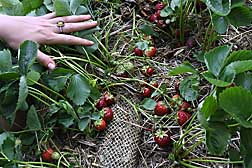Socking It to Strawberry Root Rot
Who’d have thought that compost-filled filter socks could substitute for the banned soil fumigant methyl bromide? But tests have shown that planting strawberries in these flexible tubes significantly reduced incidence of black root rot and increased yields 16- to 32-fold.
Patricia Millner, an ARS microbiologist at the Sustainable Agricultural Systems Laboratory in Beltsville, Maryland, conducted the study—the first with strawberries.
“Commercially available compost socks—sold under various trade names such as BioLogs, SiltSoxx, FilterCell, EdgeSaver, and EcoBlanket—are simply mesh tube bags,” says Millner. “When filled with compost, they usually range in diameter from 8 to 24 inches, and can be as long as neeeded to fit the application or planting row.”
The socks can be made of cotton, burlap, or other textile fibers or of plastic, including the biodegradable kind. Their uses include replacing fabric silt fences that hold back eroding soil at construction sites, road and streambank stabilization, flood control, and horticultural production.
“Black root rot is a severe threat to strawberry growers,” says Millner. “Infected plants establish poorly and produce few runners, resulting in plant beds that tend to have more bare spots and smaller yields.”
Using a scale of 1 to 5—with 5 being totally free of root rot—Millner rated the root health of strawberries grown in the compost socks. All but one scored 4 or 5. “The root health of strawberries grown without the compost ranged from 1 to 3, except for one rating of 4,” she says. “The bagged compost keeps strawberry roots away from contact with soil pathogens.”
Millner conducted the experiment on three farms in central Maryland, each with different soil types. Two were private farms, and the third was at the ARS Henry A. Wallace Beltsville Agricultural Research Center.
The compost used on the private farms was a commercial Leafgro mixture, made from leaves and yard trimmings and stuffed into cotton mesh socks. At Beltsville, Millner and colleagues used their own compost made from leaves, grass, and poultry manure placed in polyethylene-mesh socks. All socks were 8 inches in diameter.
Millner and colleagues compared two varieties of strawberries grown in the compost socks to plants grown in black plastic or matted rows. Small strawberry growers and “U-pick” operations in the northern United States tend to use matted rows, in which they grow the berry plants in perennial beds for 3 to 4 years.
Accumulated runners form the mats that act as a protective soil covering, just as black plastic does for larger operations that produce strawberries as annual bedding plants. But black plastic mulch is expensive, can funnel pesticides and other pollutants into waterways, and has to be disposed of after the annual production season is done.
Millner’s experiment is the latest in her decades-long compost studies. It is part of her research on custom-making compost mixtures for various uses. The mixtures can filter out and neutralize pesticides and other pollutants as well as trap soil and nourish plants.—By Don Comis, Agricultural Research Service Information Staff.
This research is part of Methyl Bromide Alternatives, an ARS national program (#308), described on the World Wide Web at www.nps.ars.usda.gov.
Patricia D. Millner is with the USDA-ARS Sustainable Agricultural Systems Laboratory, 10300 Baltimore Ave., Bldg. 001, Beltsville, MD 20705-2350; phone (301) 504-8387, fax (301) 504-8370.
"Socking It to Strawberry Root Rot" was published in the September 2007 issue of Agricultural Research magazine.







